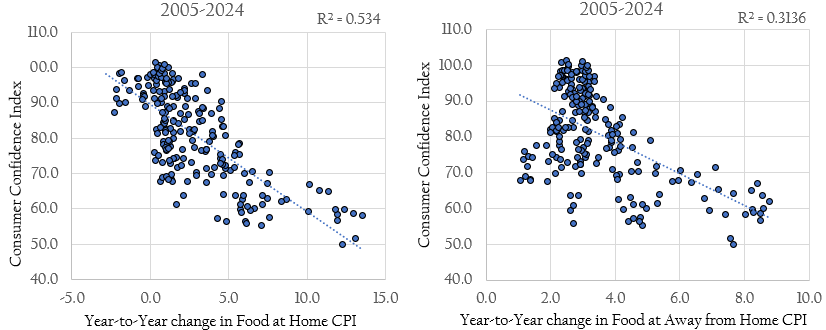The central problem with government economic policies is that many bad economic policies are politically advantageous. Hence, politicians enact policies that many of them know don’t work just to stay in power. Price controls are bad economic policy. Democrat Presidential candidate Kamala Harris wants to empower the Federal Trade Commission to stop “food price gouging” with what would amount to price ceilings.
Price ceilings cause shortages of goods and wasteful queuing, in this case for food. Why might such a bad policy win Harris, or any candidate, votes? First, many people don’t understand economics, don’t understand why price controls are bad policy. Second, a majority or people want government to secure a supply of affordable food. Consequently, increases in food costs in recent years may be a key political issue. Recent polling data indicates that economic conditions are leading concern among likely voters.
We can quantify how people feel about food costs. The food-only Consumer Price Index correlates with the consumer confidence index. Consumers feel less confident about their economic situation when food costs rise quickly, and more confident when food price inflation is at a low rate. The Bureau of Labor Statistics breaks the food-only CPI down into two subgroups: at home food and restaurant-eat out food.
As it turns out, the costs of at home food affects consumer confidence much more consistently than do costs of eat out food (a 53% statistical fit versus a 31% fit)1.

This means that we care more about the cost of eating in than the cost of eating out- an unsurprising common-sense result. The political problem with Harris’s food price controls is that while costs of eating out are rising (the green line in the next graph), the costs of eating in has stabilized (the blue line below).

Consumer confidence (the red line above) did fall when the cost of eating in increased in 2021 and 2022. Consumer confidence has been rising in 2023 and 2024, now that the food costs that really matter to regular people are barely increasing- and are relatively lower than most other components of the CPI. Convincing enough Americans that price ceilings are the best way to achieve food security is itself a difficult task. It is not that hard for those of us who do understand economics to educate others on why price controls are bad policy. Data indicates that the food security issue is fading anyway.
FDR had John Kenneth Galbraith impose price controls at the start of World War II, and this policy failed. Richard Nixon imposed price controls in response to inflation, and this policy failed. Price controls have failed when tried elsewhere in the world. Those who fail to use economics to learn from history are doomed to repeat its’ worst mistakes. Those enlightened people who oppose the new push for price controls have two advantages. We are economically correct, as is always the case. We also have an unwitting ally this time, Kamala Harris, who is focusing on a sector of the economy where pertinent prices are already under control the of Adam Smith’s Invisible Hand; the food industry. Hopefully, this will be enough for us to avoid yet another episode of wasteful price controls.
Full story here Are you the author? Previous post See more for Next postTags: Featured,newsletter



























